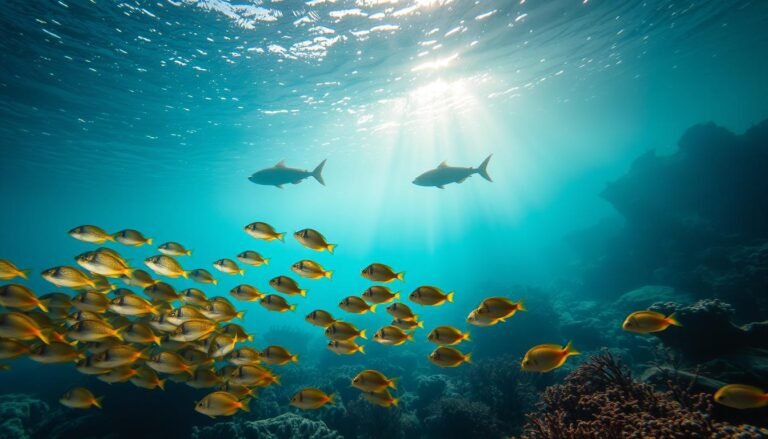Understanding the diverse world of fish species is a fascinating journey, especially for those new to Ichthyology. Exploring the basics of fish identification, including key characteristics, habitats, and classification methods, can be both exciting and informative.
The world of fish is vast, with numerous species exhibiting unique traits and inhabiting various aquatic environments. Recognizing the difference between fish species is crucial for understanding their roles in different ecosystems.
Key Takeaways
- Understanding fish species and their characteristics is essential for Ichthyology.
- Fish identification involves examining key characteristics and habitats.
- Classification methods help in categorizing the diverse fish species.
- Recognizing the differences between fish species is vital for ecological understanding.
- Fish species exhibit unique traits adapted to their habitats.
Understanding Fish Classification and Taxonomy
The scientific classification of fish provides a framework for understanding their diversity and how they have evolved over time. This classification system is essential for identifying fish types and understanding their relationships.
The Scientific Classification System for Fish
Fish are classified using a hierarchical system that includes domain, kingdom, phylum, class, order, family, genus, and species. This system, developed by Carl Linnaeus, helps in organizing the vast diversity of fish into manageable categories. For more detailed information on fish classification, you can refer to the Annotated classification of fish on Britannica.
Major Fish Groups: Cartilaginous vs. Bony Fish
Fish are broadly categorized into cartilaginous and bony fish. Cartilaginous fish, including sharks and rays, have a skeleton made of cartilage. Bony fish, which comprise the majority of fish species, have a skeleton made of bones. This distinction is fundamental in fish taxonomy explained resources.
| Characteristics | Cartilaginous Fish | Bony Fish |
|---|---|---|
| Skeleton | Cartilage | Bones |
| Examples | Sharks, Rays | Salmon, Tuna |
The Evolutionary Timeline of Fish Species
The evolutionary history of fish spans over 500 million years, with fossil records showing a gradual evolution from simple to more complex forms. The present distribution of fishes is a result of geological history, Earth’s development, and their ability to undergo evolutionary change and adapt to available habitats.
The Difference Between Fish Species: A Comprehensive Overview
The vast array of fish species on our planet showcases a remarkable diversity in anatomy, genetics, and environmental adaptations. This diversity is a result of millions of years of evolution, leading to the wide range of fish types we see today.
Anatomical Variations Across Fish Families
Fish anatomy varies significantly across different families. For instance, the body shape and size can differ greatly, from the elongated bodies of eels to the flat bodies of flounders. According to the first source, “when identifying fish, several key morphological features are considered, including body shape and size, scales and skin texture, fin shape, size, and number, color patterns and markings, and head shape and features.”

These anatomical variations are crucial for identifying fish types and understanding their adaptations to different environments.
| Fish Family | Body Shape | Distinctive Feature |
|---|---|---|
| Anglerfish | Large head, small body | Bioluminescent lure on head |
| Eels | Elongated | Snake-like movement |
| Flounders | Flat | Camouflage ability |
Genetic Diversity in Fish Populations
Genetic diversity is another key factor in understanding the differences between fish species. Genetic variations can lead to different traits and adaptations, enabling fish to survive in various environments. For example, some fish have developed genetic traits that allow them to thrive in low-oxygen environments.
“Genetic diversity is the raw material for evolution, allowing fish populations to adapt to changing environments.”
Adaptation and Specialisation in Different Environments
Fish have adapted to a wide range of environments, from freshwater rivers to deep-sea habitats. Specialised adaptations enable fish to survive and thrive in these diverse environments. For instance, fish living in coral reefs have developed vibrant coloration and complex behaviors to avoid predators.
In conclusion, the difference between fish species is a complex and fascinating topic, encompassing anatomical variations, genetic diversity, and environmental adaptations. Understanding these differences is essential for identifying fish types and appreciating their unique characteristics.
Physical Characteristics for Fish Identification
With almost every body of water hosting at least one species of fish, understanding their physical characteristics is crucial for identification. The diverse world of fish encompasses a wide range of traits that can be used to distinguish between different species.
Body Shape and Size Variations
Fish come in a variety of shapes and sizes, from the elongated bodies of eels to the flat, disk-like shapes of rays. The body shape can often indicate the fish’s habitat and behavior. For example, fast-swimming fish like tuna have streamlined bodies, while ambush predators like anglerfish have more robust bodies.
Fin Structure and Placement
The structure and placement of fins are critical for identifying fish. Fins can be used for propulsion, steering, and balance. Different species have varying fin configurations, such as the dorsal fin, anal fin, and caudal fin, which can be used to distinguish between them.
Colouration and Markings
Colouration and markings are vital for fish identification. Fish display a wide range of colors and patterns, from the vibrant hues of coral reef dwellers to the muted tones of deep-sea fish.
Camouflage Patterns
Many fish have evolved camouflage patterns to blend in with their surroundings, making them harder to spot. These patterns can mimic rocks, seaweed, or other environmental features.
Breeding Colours
Some fish exhibit bright breeding colors during mating seasons, which can be an important identification feature. These colors can signal health, dominance, or readiness to mate.
| Characteristic | Description | Example |
|---|---|---|
| Body Shape | Variations in body shape indicate habitat and behavior. | Tuna (streamlined) |
| Fin Structure | Different fin configurations aid in identification. | Sharks (heterocercal caudal fin) |
| Colouration | Range of colors and patterns for camouflage or communication. | Clownfish (bright orange and white) |
Fish Habitats and Environmental Adaptations
The adaptability of fish to different environments is a key factor in their diversity. Fish habitats play a crucial role in shaping their characteristics, leading to a wide range of species found across various aquatic environments.
Freshwater Ecosystems and Their Fish
Freshwater ecosystems, including rivers, lakes, and wetlands, are home to a variety of fish species. These environments are characterized by factors such as water flow, temperature, and vegetation, which influence the types of fish that inhabit them. For example, trout are commonly found in cold, flowing rivers, while tilapia thrive in warmer, more stagnant waters.

Marine Environments and Oceanic Species
Marine environments, encompassing coral reefs, open ocean, and deep-sea habitats, host an immense diversity of fish species. The coral reefs of Australia, for instance, are renowned for their vibrant fish populations, including species like parrotfish and angelfish. In contrast, the deep sea is home to bizarre and highly adapted species such as the anglerfish.
Estuarine Species: Masters of Adaptation
Estuaries, where freshwater rivers meet the ocean, are among the most productive ecosystems and are inhabited by fish species that are highly adaptable. These estuarine species can tolerate a range of salinity levels, making them masters of adaptation. Examples include mullet and mangrove jack, which are found in estuaries across Australia.
Deep Sea vs. Shallow Water Adaptations
Fish in deep-sea environments have evolved unique adaptations to survive the extreme conditions, such as high pressure and low light. In contrast, fish in shallow waters often rely on different strategies, such as bright coloration and complex behaviors, to survive and thrive. The differences between these adaptations highlight the incredible diversity within fish species.
In conclusion, the variety of fish habitats, from freshwater to marine environments, has led to the incredible diversity seen among fish species. Understanding these habitats and adaptations is crucial for identifying fish types and appreciating the difference between fish species.
Australian Native Fish Species
From the rivers to the coral reefs, Australia’s native fish species showcase the country’s rich aquatic biodiversity. The diverse range of fish in Australia is a result of the country’s unique geography and varied aquatic environments.
Iconic Freshwater Fish of Australia
Australia’s freshwater ecosystems are home to several iconic fish species. The Murray Cod is one of the largest freshwater fish in Australia, known for its significant size and flavorful flesh. Other notable species include the Golden Perch and the Silver Perch, both of which are popular among anglers.
| Species | Habitat | Characteristics |
|---|---|---|
| Murray Cod | Rivers and streams | Large size, carnivorous |
| Golden Perch | Rivers and billabongs | Omnivorous, migrates for breeding |
| Silver Perch | Rivers and streams | Omnivorous, schooling behavior |
Marine Species Around the Australian Coast
The marine environments around Australia are equally diverse, hosting a wide range of fish species. The Great Barrier Reef is renowned for its vibrant coral and diverse fish populations, including species like the Clownfish and the Parrotfish.
Endemic Species Found Nowhere Else
Australia is home to many endemic fish species that are found nowhere else in the world. These species have evolved in isolation, resulting in unique characteristics.
The Murray-Darling Basin Fish
The Murray-Darling Basin is home to a variety of native fish, including the Murray Cod and the Golden Perch. Conservation efforts are in place to protect these species and their habitats.
Great Barrier Reef Species
The Great Barrier Reef is one of the most biodiverse ecosystems on the planet, hosting a vast array of fish species. The Coral Trout and the Maori Wrasse are just a few examples of the many species found here.
Understanding and identifying these native fish species is crucial for their conservation. By learning more about identifying fish types and the principles of fish taxonomy explained, we can better appreciate the rich diversity of Australian fish populations.
Unique Adaptations in Australian Fish
The unique adaptations of Australian fish enable them to survive and flourish in challenging conditions. From the harsh environments of drought-prone waterways to the vibrant ecosystems of coral reefs, Australian fish have evolved remarkable traits to thrive.
Surviving in Drought-Prone Waterways
Fish in Australia’s drought-prone waterways have developed extraordinary survival strategies. Some species, like the desert goby, can survive out of water for short periods by sealing themselves in burrows or under rocks, waiting for the water to return. Others, such as the galaxias, have adapted to live in ephemeral streams, rapidly completing their life cycles before the water dries up.
Coral Reef Specialists
Coral reefs around Australia, particularly the Great Barrier Reef, are home to a vast array of fish species that have specialized to live among the coral. These fish, such as the parrotfish and butterflyfish, have evolved vibrant coloration and unique body shapes to navigate the complex reef structures and avoid predators.
Temperature Adaptations in Australian Waters
Australian fish have also adapted to the varying water temperatures across different regions. In the tropical north, fish are adapted to warmer waters, while in the temperate south, species such as the Tasmanian mackerel have adapted to cooler conditions. This adaptability highlights the difference between fish species in various Australian aquatic environments, aiding in identifying fish types across different ecosystems.
Behavioural Differences Between Fish Species
Understanding the behavioural differences between fish species is crucial for appreciating their diversity. The behaviour of fish is closely correlated with their adaptation to the total environment, including physical, chemical, and biological factors.
Feeding Strategies and Diets
Fish species exhibit a variety of feeding strategies, ranging from herbivory to carnivory. Some species are specialized feeders, while others are opportunistic omnivores. For example, Parrotfish are known to feed on algae, helping to maintain the balance of coral reefs.
“All aspects of the life of a fish are closely correlated with adaptation to the total environment, physical, chemical, and biological.” This highlights the importance of understanding the feeding behaviours of different fish species in their respective habitats.
Reproductive Behaviours
Reproductive behaviours in fish vary significantly across species. Some species exhibit complex courtship rituals, while others spawn en masse without any parental care. For instance, Angelfish are known for their elaborate mating dances.
Schooling vs. Solitary Fish
Fish species can be broadly categorized into schooling and solitary individuals. Schooling fish, such as Sardines, often gather in large numbers for protection and foraging efficiency. In contrast, solitary fish like Pike are ambush predators that rely on stealth.
Migration Patterns
Many fish species migrate over varying distances for spawning, feeding, or to reach suitable habitats. For example, Salmon migrate upstream to spawn, while Eels migrate downstream to the ocean.
| Behavioural Trait | Description | Example Species |
|---|---|---|
| Feeding Strategy | Varied diets and feeding methods | Parrotfish (Herbivore) |
| Reproductive Behaviour | Courtship rituals or mass spawning | Angelfish (Complex courtship) |
| Social Behaviour | Schooling or solitary | Sardines (Schooling) |
| Migration Pattern | Movement for spawning, feeding, or habitat | Salmon (Upstream migration) |
Practical Guide to Identifying Fish for Australian Anglers
Identifying fish is an essential part of the angling experience in Australia, requiring a combination of knowledge and observation. Australian anglers can benefit from a practical approach to identifying fish, which involves understanding visual cues, using the right tools, and being aware of common pitfalls.
Visual Identification Techniques
Visual identification is a crucial skill for anglers. It involves observing the fish’s body shape, coloration, and fin structure. For instance, the color patterns and fin shapes can significantly vary between species. Observing these characteristics from a safe distance without handling the fish can help prevent injury to both the angler and the fish.
Using Field Guides and Mobile Apps
Field guides and mobile apps are invaluable resources for identifying fish. They provide detailed descriptions and images of various species. Popular apps like Fish Identifier and guides like the Australian Fish Guide can help anglers identify their catch with confidence.
Common Misidentifications and How to Avoid Them
Misidentifying fish can have serious implications for conservation efforts and fishing regulations. Common mistakes include confusing similar-looking species or failing to recognize juvenile fish. To avoid these errors, anglers should consult multiple sources and be cautious when identifying fish that are not well-documented.
Size and Bag Limits for Common Species
Understanding size and bag limits is crucial for sustainable fishing practices. The table below outlines some common species found in Australian waters, along with their respective size and bag limits.
| Species | Size Limit (cm) | Bag Limit |
|---|---|---|
| Barramundi | 55 | 5 |
| Mulloway | 45 | 3 |
| Snapper | 40 | 4 |
By following these guidelines and staying informed, Australian anglers can contribute to the conservation of fish species while enjoying their hobby.
Read Also: Different Barramundi Species: A Complete Species Overview
Conservation Status and Threatened Australian Fish Species
Understanding the difference between fish species is crucial for identifying those that are at risk and require conservation efforts. Australian fish species, in particular, face numerous threats, making it essential to understand their conservation status.
Major Threats to Fish Diversity
Several factors contribute to the decline in fish diversity, including habitat destruction, pollution, overfishing, and climate change. These threats can be mitigated through a combination of conservation efforts and sustainable practices.
- Habitat destruction due to coastal development and dredging
- Pollution from agricultural runoff and industrial waste
- Overfishing and destructive fishing practices
- Climate change affecting water temperatures and quality
Australian Conservation Efforts
Australia has implemented various conservation measures to protect its fish species. These include establishing marine protected areas, regulating fishing practices, and promoting sustainable fishing.
Marine protected areas provide a safe haven for fish to thrive without the pressures of fishing and habitat destruction. Regulations on fishing gear and catch limits also play a crucial role in maintaining healthy fish populations.
How to Support Sustainable Fishing Practices
Consumers can support sustainable fishing by choosing products that are certified as sustainably caught or farmed. This involves looking for eco-labels and being informed about the source of seafood.
- Choose seafood from certified sustainable sources
- Support local fishing communities that practice sustainable fishing
- Avoid species that are known to be overfished or threatened
Citizen Science Opportunities
Citizen science projects offer a valuable opportunity for the public to contribute to fish conservation. By participating in surveys, monitoring programs, and reporting sightings, individuals can help researchers understand and protect fish populations.
Engaging in citizen science not only aids in conservation but also raises awareness about the importance of protecting fish diversity.
Conclusion
Becoming proficient in identifying fish species requires practice and patience. By understanding the differences between fish species and the principles of fish taxonomy explained, individuals can gain a deeper appreciation for the diverse range of fish found in Australian waters.
Throughout this article, we have explored the various aspects of fish classification, habitats, and adaptations. From the unique characteristics of Australian native fish species to the conservation efforts in place to protect them, it is clear that understanding fish diversity is crucial for promoting sustainable fishing practices.
By continuing to learn about and appreciate the differences between fish species, readers can contribute to the conservation of these incredible creatures. Whether you’re an angler, a marine enthusiast, or simply someone who appreciates the beauty of fish, understanding fish taxonomy explained can enrich your experience and foster a deeper connection with the natural world.





